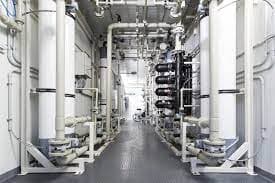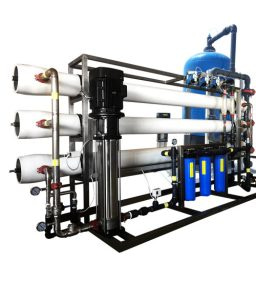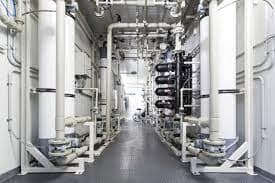Description
Brackish Water Treatment Plant
Brackish water is defined as water that has a salinity level ranging between freshwater and seawater. It is typically found in areas where fresh and saltwater sources mix, such as estuaries, coastal regions, and underground aquifers. Brackish water can be challenging to treat due to its unique characteristics, and that is where brackish water treatment plants come in. In this article, we will discuss everything you need to know about brackish water treatment plants, including their benefits, working principle, and types.
What is a Brackish Water Treatment Plant?
A brackish water treatment plant is a facility that uses a combination of physical, chemical, and biological processes to remove impurities and contaminants from brackish water, making it safe for consumption or industrial use. The plant’s primary goal is to produce freshwater that meets specific quality standards for various applications, such as drinking, irrigation, and industrial processes.
Benefits of Brackish Water Treatment Plants
There are several benefits to using brackish water treatment plants. Here are some of the most notable ones:
- Cost-effective: Brackish water treatment plants are often more cost-effective than other water treatment options, such as desalination plants, because they require less energy and resources to operate.
- Sustainable: Brackish water treatment plants use locally available water sources, which reduces the need for transporting water from distant sources, leading to lower carbon emissions.
- Versatile: Brackish water treatment plants can be used for various applications, including drinking water, irrigation, and industrial processes, making them a versatile water treatment option.
How Do Brackish Water Treatment Plants Work?
Brackish water treatment plants use a combination of physical, chemical, and biological processes to treat brackish water. The treatment process can vary depending on the specific plant design and the source of brackish water. However, the basic steps involved in treating brackish water are as follows:
- Pre-treatment: The first step involves removing large particles and debris from the water, usually through a screen or filter.
- Chemical treatment: The second step involves adding chemicals, such as coagulants and flocculants, to the water to remove suspended particles and impurities.
- Reverse osmosis: The third step involves passing the water through a semi-permeable membrane, which removes dissolved salts and other contaminants from the water.
- Post-treatment: The final step involves adding disinfectants, such as chlorine, to the water to remove any remaining bacteria and viruses.
Types of Brackish Water Treatment Plants
There are two main types of brackish water treatment plants: reverse osmosis (RO) and electrodialysis reversal (EDR). Both types use different methods to remove impurities from brackish water.
Reverse Osmosis (RO)
Reverse osmosis is a water purification process that uses a semi-permeable membrane to remove ions, molecules, and larger particles from brackish water. RO systems are highly effective at removing dissolved salts and other impurities, making them an ideal choice for treating brackish water.
Electrodialysis Reversal (EDR)
Electrodialysis reversal is a water treatment process that uses an electric field to remove ions and other impurities from brackish water. EDR systems are highly efficient and can produce high-quality water with low energy consumption.
Conclusion
Brackish water treatment plants are essential facilities that play a vital role in providing safe and clean water for various applications. They use a combination of physical, chemical, and biological processes to remove impurities and contaminants from brackish water, making it safe for consumption or industrial use. There are various benefits of using brackish water treatment plants, including cost-effectiveness, sustainability, and versatility. The treatment process of brackish water involves pre-treatment, chemical treatment, reverse osmosis, and post-treatment. There are two main types of brackish water treatment plants: reverse osmosis (RO) and electrodialysis reversal (EDR), both of which use different methods to remove impurities from brackish water.
Overall, brackish water treatment plants are crucial for providing a reliable source of freshwater in areas where brackish water is abundant. They offer several advantages over other water treatment options and can produce high-quality water at a lower cost. With the growing demand for freshwater and the increasing need for sustainable water treatment solutions, brackish water treatment plants are becoming an increasingly popular choice for water treatment.
FAQs
- How does brackish water differ from seawater? Brackish water has a lower salinity level than seawater, typically ranging between 0.5 and 30 parts per thousand (ppt), while seawater has a salinity level of around 35 ppt.
- What is the main purpose of a brackish water treatment plant? The main purpose of a brackish water treatment plant is to remove impurities and contaminants from brackish water, making it safe for consumption or industrial use.
- What are the advantages of using a brackish water treatment plant? The advantages of using a brackish water treatment plant include cost-effectiveness, sustainability, and versatility.
- What is the difference between reverse osmosis and electrodialysis reversal? Reverse osmosis uses a semi-permeable membrane to remove impurities from water, while electrodialysis reversal uses an electric field to remove impurities from water.
- What are some common applications of brackish water treatment plants? Common applications of brackish water treatment plants include drinking water, irrigation, and industrial processes.








Aqua Filter –
I recently had a water filter installed by Aquaafilter, and I couldn’t be happier with the results. The water tastes amazing, and I feel confident that I’m drinking clean, safe water.